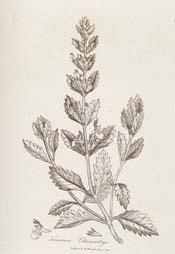

|
Germander, Wall
(Teucrium chamaedrys LINN.)
|
Germander, Wall
Botanical: Teucrium chamaedrys (LINN.)
Family: N.O. Labiatae
---Synonyms---Petit Chêne. Chasse fièvre.
---Part Used---Whole herb.
The Common or Wall Germander (Teucrium Chamaedrys) is a native of many parts of Europe, the Greek Islands and also of Syria, being found near Jerusalem, but in England is scarce and hardly indigenous being chiefly found on the ruins of old buildings and in other places where it has escaped from cultivation. It was formerly much cultivated in this country for medicinal purposes.
---Description---The roots are perennial and creeping, the square stem, 6 to 18 inches high, erect, much branched, leafy. The opposite, dark green leaves are 1/2 to 1 1/2 inch long and indented, somewhat like an oak leaf, hence the name Chamaedrys, from chamai (ground) and drus (oak). The name Germander is considered also to be a corruption of Chamaedrys. The French term this plant Petit Chêne, from the shape of the leaves, as well as Chasse fièvre, from its use in medicine.
The rose-coloured, labiate flowers, which bloom in June and July, are in three to six flowered whorls, in the axils of leafy bracts, and in leafy, terminal spikes. The whole plant is almost roughly hairy.
The fresh leaves are bitter and pungent to the taste and when rubbed, emit a strong odour somewhat resembling garlic.
---Cultivation---Germander will grow in almost any soil and is propagated by seeds,by cuttings taken in spring or summer, and by division of roots, in the autumn. Plant about a foot apart each way.
---Part Used---The whole herb, collected in July and dried in the same manner as Wood Sage.
[Top]
---Medicinal Action and Uses---Stimulant, tonic, diaphoretic, diuretic. Germander acts as a slight aperient, as well as a tonic.
The reputation of Germander as a specific for gout is of very old date, the Emperor Charles V having been cured by a decoction of this herb taken for sixty days in succession.
It has been employed in various forms and combinations, of which the once celebrated Portland Powder is one of the chief instances.
It was also used as a tonic in intermittent fevers, and is recommended for uterine obstructions.
The expressed juice of the leaves, with the addition of white wine, is held to be good in obstruction of the viscera.
Possessing qualities nearly allied to those of Horehound, a decoction of the green herb, taken with honey, has been found useful in asthmatic affections and coughs, being recommended for this purpose by Dioscorides. The decoction has also been given to relieve dropsy in its early stages.
- Culpepper tells us that it is:
- 'most effectual against the poison of all serpents, being drunk in wine and the bruised herb outwardly applied.... Used with honey it cleanseth ulcers and made into an oil and the eyes anointed therewith, taketh away dimness and moisture. It is also good for pains in the side and cramp.... The decoction taken for four days driveth away and cureth tertian and quartan agues. It is also good against diseases of the brain, as continual headache, falling sickness, melancholy, drowsiness and dulness of spirits, convulsions and palsies.'
He further states that the powdered seeds are good against jaundice. The tops, when in flower, steeped twenty-four hours in white wine will destroy worms.
[Top]
Common Name Index
A MODERN HERBAL Home Page
Bear in mind "A Modern Herbal" was written with the conventional wisdom of the early 1900's. This should be taken into account as some of the information may now be considered inaccurate, or not in accordance with modern medicine.
© Copyright Protected 1995-2004 botanical.com

|

